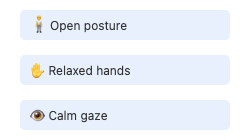Welcome to Manage 1:1 Conflict! In this course, you’ll learn how to handle disagreements with confidence, clarity, and respect. Conflict is a normal part of working with others, but it doesn’t have to be stressful or overwhelming. Let us explore how to turn tense moments into opportunities for better understanding and stronger relationships.
By the end of this lesson, you’ll be able to:
- Start difficult conversations in a way that feels safe and respectful for everyone involved
- Communicate your concerns clearly, without causing unnecessary defensiveness
- Stay calm and composed, even when emotions run high
These conflict management basics will help you feel more confident in any situation. By practicing these techniques, you’ll build trust, strengthen your relationships, and contribute to a more positive environment for everyone.
One of the trickiest parts of handling conflict is just getting the conversation started. It’s normal to feel nervous or unsure about how to bring up a problem. Sometimes, people avoid the issue completely, or they mention it in a way that makes things even more tense.
When you feel like someone isn’t listening to you, how you start the conversation can make a big difference. For example, saying, "You never listen to my ideas," can sound like an accusation and might make the other person defensive. Instead, saying something like, "I'd like to talk about how we can make sure both of our ideas get heard," feels more like an invitation to work together. This second approach helps set a positive, problem-solving tone right from the start.
Being clear is important. Focus on what you’ve actually seen or experienced, and what you’d like to change. For example, instead of saying something vague like, "Things aren’t working," you could say, "I’ve noticed I feel a bit stressed when our meetings start late, and I’ve seen this happen a few times this month. Can we talk about what might help us start on time?" This gives the other person something specific to respond to and shows respect for their perspective. Bringing up issues early, while they’re still small, makes the conversation easier and less stressful. Your goal isn’t to catch someone off guard with criticism, but to create a safe space for a constructive, honest, and respectful conversation.
You can use the collaborative communication framework to keep conflict conversations constructive and collaborative:

- Use "I" statements: Focus on your own feelings and experiences rather than blaming.
- Frame problems as shared challenges: Invite the other person to work with you on a solution.
- Use softening phrases to show openness: Signal that you want to understand their perspective, not just criticize.
When addressing conflict, it's important to aim for a balance of kindness and clarity. Be gentle, but also clear about what you need. Here’s how this might sound in a real conversation:
- Jessica: Ryan, can we talk about something I’ve noticed in our conversations?
When things get tense and perspectives differ, staying calm is one of the best tools you have. Being calm doesn’t mean you have to hide your feelings or pretend everything is okay when it’s not. It just means you’re choosing to manage your emotions so the conversation doesn’t get off track or become more heated than it needs to be.
Your body language can help set the tone. Try to keep an open posture—sit or stand in a way that feels relaxed, not closed off. Use a calm, steady gaze and make gentle eye contact (but don’t stare). Let your hands rest naturally instead of clenching them. These small things show you’re open to talking and willing to listen, which can help the other person feel more comfortable too.

If you notice yourself getting upset, pause and take a slow, deep breath before you respond. Even a short pause can help you collect your thoughts and avoid saying something you might regret. You can even say, "That’s an important point. Let me think about it for a moment," to give yourself a little extra time.
Staying calm can actually help the other person calm down, too. If they start to raise their voice, try lowering yours a bit. If they start talking quickly, slow down your own speech. This is called emotional regulation and is about focusing on what you can control: your own reactions, words, and body language. You don’t have to fix the other person’s emotions, just do your best to keep yourself steady. This makes it much easier for both of you to work through the conflict together.
As you prepare to practice these essential skills, remember that managing conflict effectively is like building any other important capability: it requires consistent practice, patience with yourself, and persistence through setbacks. In your upcoming practice sessions, you'll have valuable opportunities to apply these techniques in realistic scenarios, gradually building your confidence and refining your approach within a safe, supportive environment where mistakes become learning opportunities.
